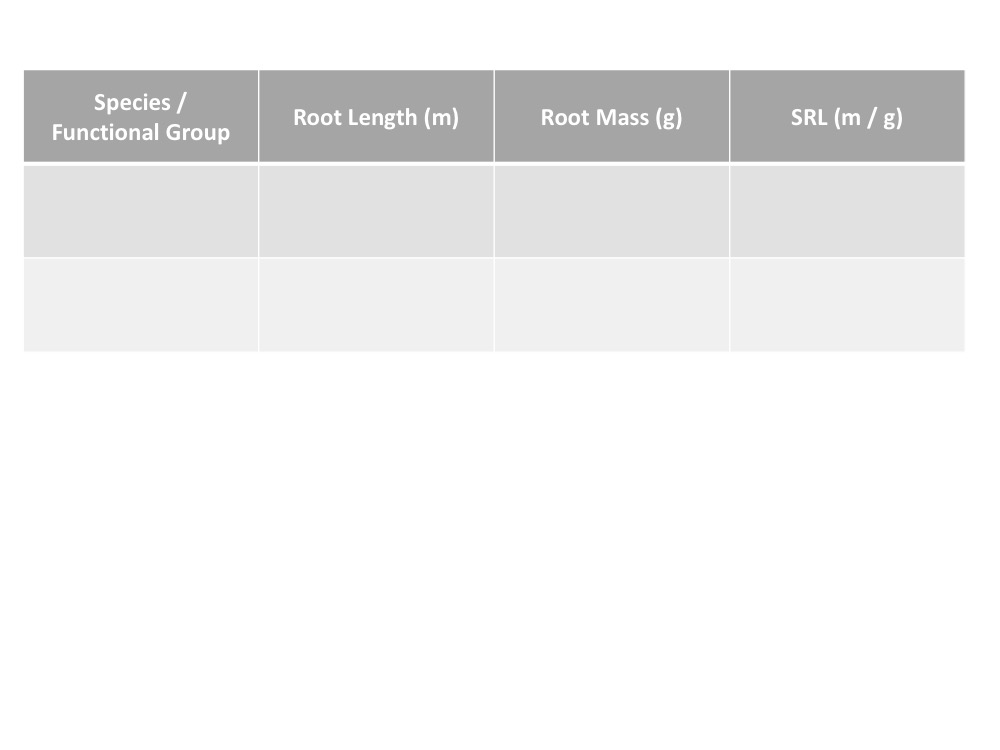F/RS 310
Assignment #5
Specific Root Length (SRL)
32 Points Possible
Introduction
Plants must acquire water and nutrients from the soil in order to meet the demands of the leaves. If plants cannot acquire these belowground resources fast enough, photosynthesis will decrease and reduce growth of the whole plant. The most important factor that explains variability in nutrient and water uptake rates is the total surface area of the root system. If a plant has a lot of root surface area, then it is in contact with a lot of the resources available in the soil. However, as you know, roots (and other plant tissue) are costly to construct and so building a lot of root surface area can be “expensive”. Some plants, however, are more efficient at building surface area than others – and by ‘efficient’ I mean that they can build a lot of surface area for very little biomass invested. The way we can quantify the structure of the root system relative to how much biomass was invested is by calculating SRL. SRL is the length of the root system divided by the mass of the root system (m/g). The larger the SRL value, the more surface area a root system has relative to biomass investment. Because surface area is the biggest factor in understanding resource uptake rates, plants with high SRL generally have fast rates of uptake. For this activity you will measure the SRL of an individual plant and then compare your data to other groups.
Objective
The objective of this assignment is to help students gain a deeper understanding of how plant root systems can impact their growth strategies by quantifying root systems of different plant functional groups.
Student Learning Objectives
After completing this assignment students will be able to:
- Measure root length using grid-cell technique
- Describe Specific Root Length (SRL) and its implications on plant growth
- Calculate SRL of two different species in different functional groups
- Interpret SRL data in the context of resource acquisition
- Write a full lab report in the style of a scientific paper
Description of Lab Activities
1) Root length – You can measure root length by washing the soil away from plants roots, scan the root system of interest, and then estimate the total length with a using a sheet of grid paper.
2) After your roots are clean, you can “subsample” the root system. Starting from the bottom of the root system, cut about ¼ of the root system away working from the bottom to the top of the root system.
3) Get a sheet of grid paper from your instructor and have them show you how to estimate root length.
4) Place the subsample of the root system into a coin envelope and put your group name and lab meeting time on the outside of the envelope and give to your instructor.
Results
Calculate root length by filling in the data in the table provided below.

Lab Report
- Introduction (7 points)
- Importance of belowground resources to plant growth
- Root structure (fine vs. coarse roots)
- Introduce what SRL is and units
- Hypotheses for how SRL would differ across growth forms
- Materials & Methods (7 points)
- Describe everything you did
- Results (7 points)
- Plot your SRL data as a bar graph with appropriate legend
- Discussion (7 points)
- Did your results meet your expectations? Why/why not?
- Compare your results to 2 papers that report SRL for the same functional groups. How did your data compare to the data presented in these papers?
- Why would SRL be an advantage for some functional groups but not others?
- References (4 points)
- Cite your references.
8 points for organization and writing. Writing will be judged on clarity, spelling, and complete sentences.